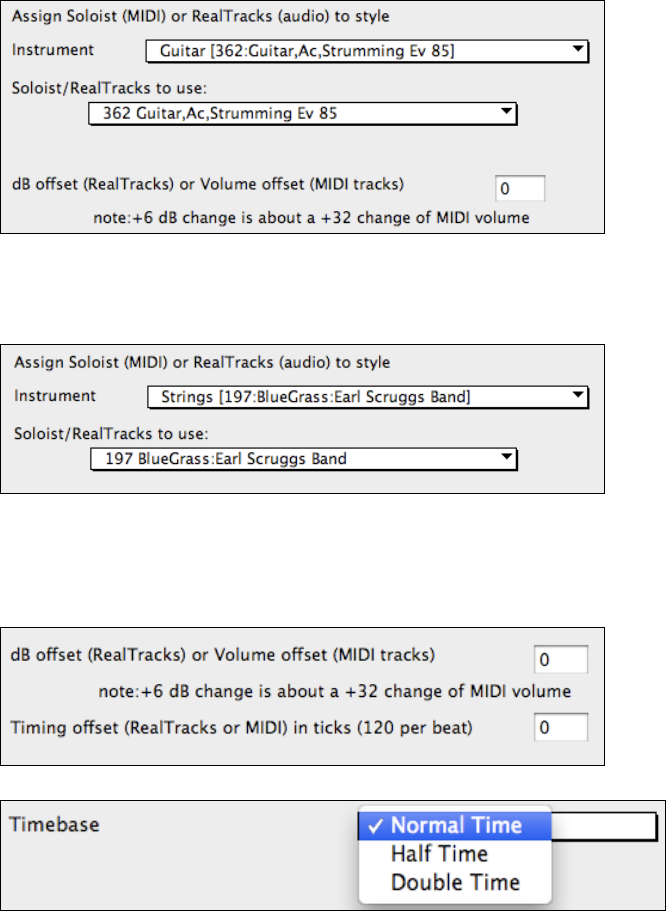User Guide
Table Of Contents
- PG Music Inc. License Agreement
- Table of Contents
- Chapter 1: Welcome to Band-in-a-Box!
- Chapter 2: QuickStart Tutorial
- Chapter 3: Band-in-a-Box 2010.5 for Macintosh
- Welcome to Band-in-a-Box 2010.5
- New Features in Band-in-a-Box 2010
- More New RealTracks
- QuickStart Tutorial
- Quick Song Settings
- Save Default Mix
- Improved Audio Rendering
- DAW Plug-in Mode
- Freeze Tracks
- RealTracks Enhancements
- New Favorite Songs/Styles Dialog
- Rendering Tracks
- StylePicker Enhancements
- New in the StyleMaker
- Chapter 4: The Main Screen
- Chapter 5: Guided Tour of Band-in-a-Box
- Chapter 6: Band-in-a-Box PowerGuide
- RealTracks
- RealDrums
- Song Settings
- The Chordsheet
- Chord Preview/Builder
- MIDI file “Chord Wizard”
- Applying Styles
- The StylePicker
- Playing, Pausing, and Stopping Songs
- Changing Volume, Panning, Reverb, Chorus, Bank
- Freeze Tracks
- Saving Songs
- Preferences – User Settings
-
- Show Chords with push/rest chars
- Metronome During Recording
- Harmony Volume Adjust
- OK to Load Style with songs
- Write Guitar part on 6 channels
- Turn External Keyboard’s Local On at end of session
- OK to beep with messages
- OK to prompt to reduce/expand
- For Roman Numerals in minor keys, use relative major
- Save Button on main screen works as Save As
- Name MIDI files with .MID extension
- Allow larger fonts on Chordsheet
- Color for Chordsheet Area
-
- Other Editing Features
- MIDI Setup
- The JukeBox
- Chapter 7: Notation and Printing
- Chapter 8: Automatic Music Features
- Chapter 9: Recording Tracks
- Chapter 10: Audio Features
- Chapter 11: Wizards, Tutors, and Fun
- Chapter 12: User Programmable Functions
- Chapter 13: CoreMIDI and Apple DLS Synth
- Chapter 14: Reference
- PG Music Inc.
- Index
- Registration Form

Chapter 12: User Programmable Functions
237
Resolution
Styles can either have Triplet (swing eighth notes) Straight (even eighth or sixteenth notes) resolution.
‘Riff’ voicing type uses chord tones
This is an option for piano, guitar, and string patterns. If selected, voicing modifies to match the chord and scale.
Deselect for a simple transpose ignoring chord type.
Assign Soloist (MIDI) or RealTracks (audio) to style
Styles can contain RealTracks and RealDrums or MIDI soloists.
To assign RealTracks to a style set the “Instrument” to use, and the RealTracks #. In the example, we are using
RealGuitar for the Guitar track.
Styles can have multiple RealTracks. For example, you could have RealPedalSteel and RealAcousticGuitar. And
also RealDrums.
Styles can also use MIDI soloists. For example, make a style with a banjo part that has the same quality as the
Band-in-a-Box Banjo Soloist. Here we are assigning an Earl Scruggs Bluegrass solo to the Strings part.
Use the dB or volume offset to match the level of the Soloist or RealTrack to the other instruments in the style. The
acceptable range is a MIDI setting of –127 to 127. When applying this offset to audio (RealTracks) a value of 32 is
approximately 6dB.
The Timing offset (RealTracks or MIDI) in ticks (120 per beat) setting allows you to make a song or style with a
more "laid-back" feel for a certain RealTracks.
The Timebase option allows styles to use Half Time and Double Time RealTracks.
For example, you can make a Jazz Ballad style (tempo 65) that uses a Sax Soloist at tempo 140 (playing double
time).










